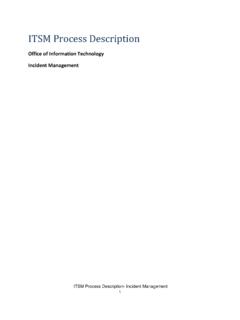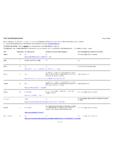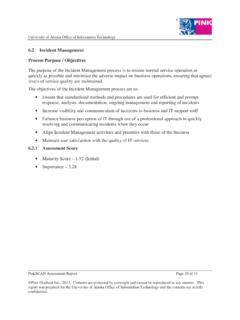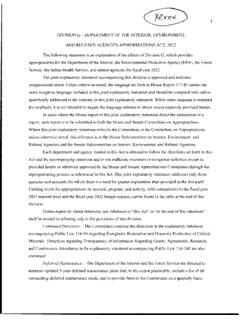Transcription of OW O ANTS MALS UNIT 7: Your Environment NEED CH OTHER?
1 REACH 2015 K-12 Outreach, UAHOW DO PLANTS AND ANIMALSNEED EACH OTHER? REACHUNIT 7: Your EnvironmentLesson 18 Grades 2-3 INSTRUCTIONS1 OverviewIn this lesson, students will learn about what plants and animals need to survive and how plants and animals are interdependent. They will explore the interdependency and impact of the local community on the local Environment . ObjectivesOn successful completion of this lesson, students will be able to: list four things plants and animals need to survive; identify how plants and animals need each other; draw and label a picture showing the relationship of plants and animals in the Environment .
2 And describe how the local community and the plants and animals in the local Environment are StandardsAlaska Science Standards / Grade Level Expectations[3] The student demonstrates an understanding of the processes of science by asking questions, predicting, observing, describing, measuring, classifying, making generalizations, inferring, and communicating.[3] The student demonstrates an understanding of the processes of science by observing and describing the student s own world to answer simple questions.[3] The student demonstrates an understanding that interactions with the Environment provide an opportunity for understanding scientific concepts by observing local conditions that determine which plants and/or animals survive.
3 [3] The student demonstrates an understanding of how science explains changes in life forms over time, including genetics, heredity, the process of natural selection, and biological evolution by sorting Alaskan plants and /or animals using physical characteristics. ( , leaves, beaks) 3] The student demonstrates an understanding of how science explains changes in life forms over time, including genetics, heredity, the process of natural selection, and biological evolution by describing how some traits ( , claws, teeth, camouflage) of living organisms have helped them survive as a species.
4 [3] The student demonstrates an understanding of the structure, function, behavior, development, life cycles, and diversity of living organisms by sorting animals and plants into groups based on appearance and 2015 K-12 Outreach, UAHOW DO PLANTS AND ANIMALSNEED EACH OTHER? REACHUNIT 7: Your EnvironmentLesson 18 Grades 2-3 INSTRUCTIONS2[3] The student demonstrates an understanding of the structure, function, behavior, development, life cycles, and diversity of living organisms by observing and comparing external features of plants and animals that may help them grow, survive, and English / Language Arts Write informative/explanatory texts to examine a topic and convey ideas and information Cultural Standards[A] Culturally knowledgeable students are well grounded in the cultural heritage and traditions of their community.
5 [E] Culturally knowledgeable students demonstrate an awareness and appreciation of the relationships and processes of interaction of all elements in the world around them Students who meet this cultural standard are able to:[ ] recognize and build upon the interrelationships that exist among the spiritual, natural, and human realms in the world around them, as reflected in their own cultural traditions and beliefs as well as those of others.[ ] understand the ecology and geography of the bioregion they inhabit. Bering Strait School District Scope & Sequence2nd grade sequence #4: Living Things (Animals)B.
6 Understand the needs of Understands how we classify Understands how animals grow and Uses scientific processes and inquiry to directly support the concepts of living grade sequence #4: Living Things (Animals)B. Observe and compare external features of animals that may help them grow, survive, and reproduce. C. Sort Alaskan animals using physical Sort animals into groups based on appearance and Understand what vertebrates Understand what invertebrates Use scientific processes and inquiry to directly support concepts on 2015 K-12 Outreach, UAHOW DO PLANTS AND ANIMALSNEED EACH OTHER?
7 REACHUNIT 7: Your EnvironmentLesson 18 Grades 2-3 INSTRUCTIONS3 Materials A Log s Life by Wendy Pfeffer Chart paper Marker Plant and Animal Cards (one set per group of three students) Student Worksheet: How Plants and Animals Need Each Other Optional: Student Worksheet: Plants, Animals, and the Local CommunityMultimediaREACH Multimedia K-3: Watch the Balance of Nature Available at: ResourcesThe Busy Tree by Jennifer WardThis Is the Sea that Feeds Us by Robert F. BaldwinOne Small Place in a Tree by Barbara BrennerOver and Under the Snow by Kate MessnerWho Will Plant a Tree?
8 By Tom LeonardWildlife Notebook Series, alaska department of fish and GameActivity Preparations1. Read through the entire lesson, including the teacher background information in the Whole Picture Create a chart with the title Interdependency of Plants and Animals . Construct it according to the 2015 K-12 Outreach, UAHOW DO PLANTS AND ANIMALSNEED EACH OTHER? REACHUNIT 7: Your EnvironmentLesson 18 Grades 2-3 INSTRUCTIONS4 Example of chart: Interdependency of Plants and Animals1. Animals breathe oxygen and exhale carbon dioxide. Plants take in carbon dioxide and release oxygen back into the Animals need plants for food and Plants need animals for seed dispersal and Some animals eat plants.
9 Some animals eat other animals. When animals die and decompose, the plants use the nutrients that were deposited back into the soil from the decomposing Forests and wetlands filter water so it is clean, and animals need clean water to Make copies of Student Worksheet: How Plants and Animals Need Each Other If needed, make additional copies of the Plant and Animal Cards (Appendix). 4. If using, make copies of Student Worksheet: Plants, Animals, and the Local Community5. If doing the extension activity with a guest speaker, that visit will need to be arranged. Invite a cultural knowledge bearer or elder to speak to the class about the traditional ways the local community is dependent on the Environment and how living things in the Environment are dependent upon the local Picture I upiaq, Yup ik, and Siberian Yupik people have an intimate knowledge of the landscape, plants, animals, and seasonal timing of life in their local area (Barnhardt and Kawagley, 2005).
10 This understanding is crucial for subsistence living, for plants, animals, and humans all depend on one another for survival. Plants are producers they take energy from the sun, nutrients from the ground, and water to grow and produce their flowers, seeds, and berries. They also release oxygen, which all animals, including humans, need to survive. Animals are consumers and they all depend on plants for survival. Some eat plants directly, while others eat animals that eat the plants. In turn, some plants depend on animals to help spread their seed. Decomposing animal carcasses can also provide nutrients for plants to grow.








